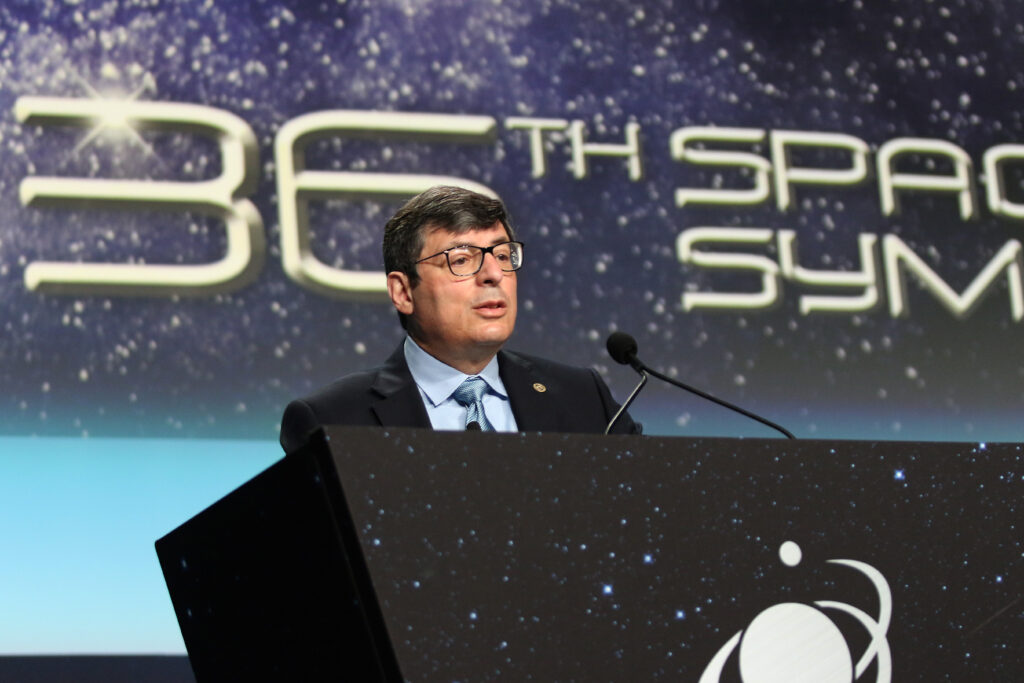COLIN CLARK

COLORADO SPRINGS: After a series of recent tussles over who manages what in space, National Reconnaissance Office Director Christopher Scolese today announced a new agreement between his office, the National Geospatial-Intelligence Agency, the Space Force and Space Command, dubbed the Protected Defense Strategic Framework.
“This high level document formalizes end-to-end operations between DoD and the IC on everything from acquisition to operations. In practical terms, it defines and deconflicts each of our roles. It drives consistent and deliberate coordination at multiple levels,” Scolese said during a speech at the annual Space Symposium. “It establishes crisis planning, and improves communication. And most importantly, it establishes an unprecedented level of collaboration on all space security matters.”
The document, which Breaking Defense has learned is classified, includes a formal list of the missions each organization tackles, in hopes of creating clear boundaries for all involved.
There has clearly been a need to ensure these organizations, which have some overlapping missions and duties, don’t needlessly duplicate what the other does, nor snatch missions or budgets from their fellows. The fights between them have, at times, spilled out into the public. Despite that, Scolese followed the timeless manner of officials all over the world and insisted that everything is fine.
“And let’s clear up the way we work with Space Force and SPACECOM. We have a great relationship, as Gen. (Jay) Raymond (of the Space Force) talked and all the other speakers have mentioned,” Scolese said. He noted that he, Raymond, and NASA head Bill Nelson “flew here together on the same plane and had a great conversation about what the future should look like.”
On top of that, the trio spent Sunday night at a reception with Gen. James Dickinson, commander of Space Command, which was, Scolese said, “a fine reception.”
During a press briefing later in the day, Dickinson was asked about the new agreement. He said he had not heard Scolese’s remarks, noting accurately that reporters were “probably not going to be satisfied with this answer.”
UPDATE BEGINSThe next day Dickinson provided Breaking Defense a statement on the framework, portraying it as a reaction to the Chinese and Russian threats:
“Chinese and Russian space activities present serious and growing threats to U.S. national security interests. To further streamline our unity of effort, United States Space Force, United States Space Command, and National Reconnaissance Office developed a framework focused on strategic-level collaboration that increases national security collaboration. The memorandum formalizes end-to-end coordination between the Department of Defense and Intelligence Community, and between acquisitions and operations.” UPDATE ENDS
China’s ‘Unquenchable Drive’
During his speech, Scolese offered up a pretty tough view of US relations with China and Russia in space.
“What China and Russia have already shown is that space is now a competitive race. It’s a competition. It’s a fight. And if we’re not careful, it’s going to become a knockdown drag out brawl, something we all want to avoid. Let’s not forget how much money, manpower and research they, Russia and China, but principally China, are spending on space,” the DNRO said. “We’re talking about counterspace capabilities, newer and better weapons, and we won’t even go into the cyber attacks just yet.
“In short, China’s showing an unquenchable drive to get ahead of us and take what’s been our operational intelligence advantage since JFK was in office.”
The stakes are high, he made clear: “And if we, and by ‘we’ I mean all of us in this audience, don’t step up our game, we risk losing the high ground. China’s very smart, they have very capable people. They’re very driven, and they don’t have the constraints we have.”
The NRO, and the US generally, isn’t standing still as the Chinese vault ahead, he said.
“Technology and innovation have been the hallmarks of the NRO, and space in general, for as long as the NRO has been around. To quote my colleague and also a good friend over at NSA, the NRO is unparalleled in its innovation, creativity, and willingness to take risks. Just take a look at the last year,” he said.
The NRO set a record in 2020, putting “12 payloads in orbit on six launches from two continents in the middle of a pandemic. If you count the four payloads we launched earlier this year. that’s almost a payload a month.”
No comments:
Post a Comment